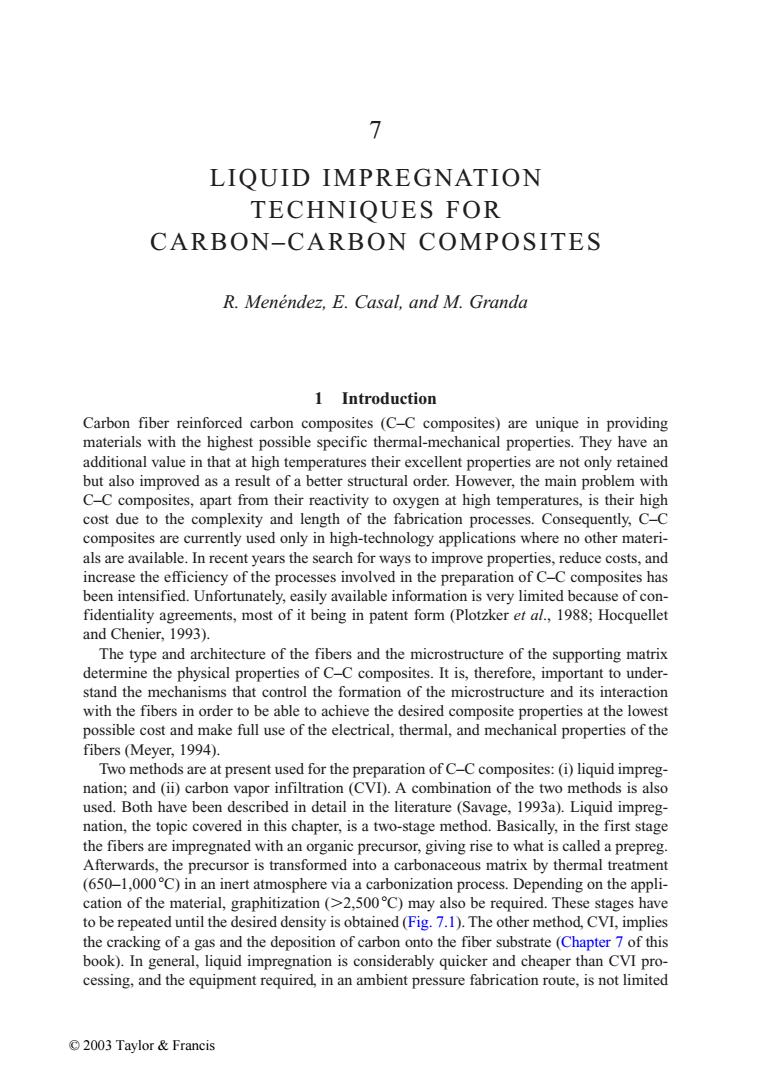正在加载图片...

7 LIQUID IMPREGNATION TECHNIQUES FOR CARBON-CARBON COMPOSITES R.Menendez,E.Casal,and M.Granda 1 Introduction Carbon fiber reinforced carbon composites (C-C composites)are unique in providing materials with the highest possible specific thermal-mechanical properties.They have an additional value in that at high temperatures their excellent properties are not only retained but also improved as a result of a better structural order.However,the main problem with C-C composites,apart from their reactivity to oxygen at high temperatures,is their high cost due to the complexity and length of the fabrication processes.Consequently,C-C composites are currently used only in high-technology applications where no other materi- als are available.In recent years the search for ways to improve properties,reduce costs,and increase the efficiency of the processes involved in the preparation of C-C composites has been intensified.Unfortunately,easily available information is very limited because of con- fidentiality agreements,most of it being in patent form(Plotzker et al.,1988;Hocquellet and Chenier,1993). The type and architecture of the fibers and the microstructure of the supporting matrix determine the physical properties of C-C composites.It is,therefore,important to under- stand the mechanisms that control the formation of the microstructure and its interaction with the fibers in order to be able to achieve the desired composite properties at the lowest possible cost and make full use of the electrical,thermal,and mechanical properties of the fibers (Meyer,1994). Two methods are at present used for the preparation of C-C composites:(i)liquid impreg- nation;and(ii)carbon vapor infiltration (CVI).A combination of the two methods is also used.Both have been described in detail in the literature(Savage,1993a).Liquid impreg- nation,the topic covered in this chapter,is a two-stage method.Basically,in the first stage the fibers are impregnated with an organic precursor,giving rise to what is called a prepreg. Afterwards,the precursor is transformed into a carbonaceous matrix by thermal treatment (650-1,000C)in an inert atmosphere via a carbonization process.Depending on the appli- cation of the material,graphitization (>2,500C)may also be required.These stages have to be repeated until the desired density is obtained (Fig.7.1).The other method,CVI,implies the cracking of a gas and the deposition of carbon onto the fiber substrate (Chapter 7 of this book).In general,liquid impregnation is considerably quicker and cheaper than CVI pro- cessing,and the equipment required,in an ambient pressure fabrication route,is not limited ©2003 Taylor&Francis7 LIQUID IMPREGNATION TECHNIQUES FOR CARBON–CARBON COMPOSITES R. Menéndez, E. Casal, and M. Granda 1 Introduction Carbon fiber reinforced carbon composites (C–C composites) are unique in providing materials with the highest possible specific thermal-mechanical properties. They have an additional value in that at high temperatures their excellent properties are not only retained but also improved as a result of a better structural order. However, the main problem with C–C composites, apart from their reactivity to oxygen at high temperatures, is their high cost due to the complexity and length of the fabrication processes. Consequently, C–C composites are currently used only in high-technology applications where no other materials are available. In recent years the search for ways to improve properties, reduce costs, and increase the efficiency of the processes involved in the preparation of C–C composites has been intensified. Unfortunately, easily available information is very limited because of confidentiality agreements, most of it being in patent form (Plotzker et al., 1988; Hocquellet and Chenier, 1993). The type and architecture of the fibers and the microstructure of the supporting matrix determine the physical properties of C–C composites. It is, therefore, important to understand the mechanisms that control the formation of the microstructure and its interaction with the fibers in order to be able to achieve the desired composite properties at the lowest possible cost and make full use of the electrical, thermal, and mechanical properties of the fibers (Meyer, 1994). Two methods are at present used for the preparation of C–C composites: (i) liquid impregnation; and (ii) carbon vapor infiltration (CVI). A combination of the two methods is also used. Both have been described in detail in the literature (Savage, 1993a). Liquid impregnation, the topic covered in this chapter, is a two-stage method. Basically, in the first stage the fibers are impregnated with an organic precursor, giving rise to what is called a prepreg. Afterwards, the precursor is transformed into a carbonaceous matrix by thermal treatment (650–1,000 C) in an inert atmosphere via a carbonization process. Depending on the application of the material, graphitization (
2,500 C) may also be required. These stages have to be repeated until the desired density is obtained (Fig. 7.1). The other method, CVI, implies the cracking of a gas and the deposition of carbon onto the fiber substrate (Chapter 7 of this book). In general, liquid impregnation is considerably quicker and cheaper than CVI processing, and the equipment required, in an ambient pressure fabrication route, is not limited © 2003 Taylor & Francis